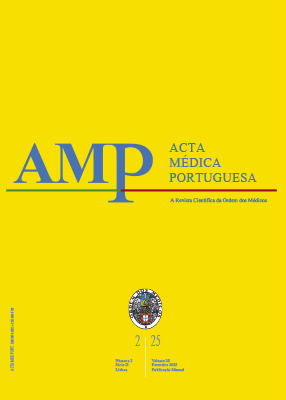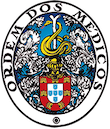Urinary Tract Infections in Children: Changing Trends in Etiology and Local Resistance Patterns over a Three-Year Period
DOI:
https://doi.org/10.20344/amp.21630Keywords:
Child, Drug Resistance, Bacterial, Urinary Tract Infections/drug therapy, Urinary Tract Infections/etiology, Urinary Tract Infections/microbiologyAbstract
Introduction: Urinary tract infections are common in pediatrics. Knowledge of local resistance patterns is crucial to guide empirical antibiotic therapy. We aimed to review the pathogens implicated in urinary tract infections, local resistance patterns, and the impact of switching first-line empirical antibiotic regimens.
Methods: We conducted a cross-sectional study including pediatric patients performing urine cultures in a hospital in northern Portugal over two periods: 2019 (group 1) and 2022 (group 2). Between time periods, an internal guideline was implemented recommending cefuroxime as the first-line choice for empirical treatment of urinary tract infections, according to local resistance patterns. Uropathogens, empirical antibiotic choices and resistance patterns were compared among groups.
Results: The final sample included 402 cases of urinary tract infections in group 1 and 398 in group 2. Escherichia coli was the most common uropathogen (79.4 - 83.3%), followed by Proteus mirabilis and Klebsiella spp. The most common empirical antibiotic in group 1 was amoxicillin-clavulanate (A-C), as opposed to cefuroxime in group 2 (p < 0.001). The most common resistance was to ampicillin (39.3% - 39.7%). Resistance to A-C slightly decreased (33.1% vs 27.4%, p = 0.079), while resistance to cefuroxime (4.7% vs 3.3%, p = 0.292) and trimethoprim-sulfamethoxazole (TMP-SMX) remained similar (15.2% vs 14.1%, p = 0.659). Resistances to nitrofurantoin (9.0% vs 0.3%, p < 0.001) and fosfomycin (1.7% vs 0.3%, p < 0.036) significantly decreased from group 1 to group 2.
Conclusion: E.coli remains the predominant pathogen in pediatric urinary tract infections. Resistance to A-C in our sample was high (33.1%). The switch from A-C to cefuroxime as first-line agent resulted in a decreasing trend in A-C resistance, while cefuroxime resistance remained low and even slightly lower.
Downloads
References
Sobel JD. Pathogenesis of urinary tract infection. Role of host defenses. Infect Dis Clin North Am. 1997;11:531-49. DOI: https://doi.org/10.1016/S0891-5520(05)70372-X
Spencer JD, Schwaderer A, McHugh K, Hains DS. Pediatric urinary tract infections: an analysis of hospitalizations, charges, and costs in the USA. Pediatr Nephrol. 2010;25:2469-75. DOI: https://doi.org/10.1007/s00467-010-1625-8
Leung AK, Wong AH, Leung AA, Hon KL. Urinary tract infection in children. Recent Pat Inflamm Allergy Drug Discov. 2019;13:2-18. DOI: https://doi.org/10.2174/1872213X13666181228154940
Morello W, La Scola C, Alberici I, Montini G. Acute pyelonephritis in children. Pediatr Nephrol. 2016;31:1253-65. DOI: https://doi.org/10.1007/s00467-015-3168-5
Shaikh N, Morone NE, Bost JE, Farrell MH. Prevalence of urinary tract infection in childhood: a meta-analysis. Pediatr Infect Dis J. 2008;27:302-8. DOI: https://doi.org/10.1097/INF.0b013e31815e4122
Brandström P, Hansson S. Urinary tract infection in children. Pediatr Clin North Am. 2022;69:1099-114. DOI: https://doi.org/10.1016/j.pcl.2022.07.003
Vazouras K, Velali K, Tassiou I, Anastasiou-Katsiardani A, Athanasopoulou K, Barbouni A, et al. Antibiotic treatment and antimicrobial resistance in children with urinary tract infections. J Glob Antimicrob Resist. 2020;20:4-10. DOI: https://doi.org/10.1016/j.jgar.2019.06.016
Demir M, Kazanasmaz H. Uropathogens and antibiotic resistance in the community and hospital-induced urinary tract infected children. J Glob Antimicrob Resist. 2020;20:68-73. DOI: https://doi.org/10.1016/j.jgar.2019.07.019
Rosado MR, Molina AG, Velasco AL, Chinchilla GC, Lana PV, Izquierdo EO, et al. Urinary tract infection in pediatrics: study of uropathogens and their resistance in a Madrid hospital. Arch Esp Urol. 2022;75:791-7. DOI: https://doi.org/10.56434/j.arch.esp.urol.20227509.115
Schlager TA. Urinary tract infections in children younger than 5 years of age: epidemiology, diagnosis, treatment, outcomes and prevention. Paediatr Drugs. 2001;3:219-27. DOI: https://doi.org/10.2165/00128072-200103030-00004
Miron D, Grossman Z. The diagnosis and therapy of first community acquired urinary tract infection in children. Harefuah. 2009;148:778-82, 791, 792.
Oh MM, Kim JW, Park MG, Kim JJ, Yoo KH, Moon du G. The impact of therapeutic delay time on acute scintigraphic lesion and ultimate scar formation in children with first febrile UTI. Eur J Pediatr. 2012;171:565- 70. DOI: https://doi.org/10.1007/s00431-011-1614-3
A’t Hoen L, Bogaert G, Radmayr C, Dogan HS, Nijman RJ, Quaedackers J, et al. Update of the EAU/ESPU guidelines on urinary tract infections in children. J Pediatr Urol. 2021;17:200-7. DOI: https://doi.org/10.1016/j.jpurol.2021.01.037
Erol B, Culpan M, Caskurlu H, Sari U, Cag Y, Vahaboglu H, et al. Changes in antimicrobial resistance and demographics of UTIs in pediatric patients in a single institution over a 6-year period. J Pediatr Urol. 2018;14:176.e1-5. DOI: https://doi.org/10.1016/j.jpurol.2017.12.002
Buettcher M, Trueck J, Niederer-Loher A, Heininger U, Agyeman P, Asner S, et al. Swiss consensus recommendations on urinary tract infections in children. Eur J Pediatr. 2021;180:663-74. DOI: https://doi.org/10.1007/s00431-020-03714-4
Direção-Geral da Saúde. Norma da Direção-Geral da Saúde 008/2012 de 16/12/2012. Diagnóstico e tratamento da infeção do trato urinário em idade pediátrica. [cited 2023 Aug 17]. Available from: https://www.spp. pt/UserFiles/file/Seccao_Nefrologia/Norma%20de%20Orientacao%20 Clinca_ITU.pdf.
Cag Y, Haciseyitoglu D, Ozdemir AA, Cag Y. Antibiotic resistance and bacteria in urinary tract infections in pediatric patients. Medeni Med J. 2021;36:217-24.
Choi UY, Han SB, Lee SY, Kang JH, Kim SM, Ma SH. Regional differences in phylogenetic group of Escherichia coli strains isolated from children with urinary tract infection in Korea. Korean J Pediatr. 2012;55:420-3. DOI: https://doi.org/10.3345/kjp.2012.55.11.420
Mattoo TK, Shaikh N, Nelson CP. Contemporary management of urinary tract infection in children. Pediatrics. 2021;147:e2020012138. DOI: https://doi.org/10.1542/peds.2020-012138
Diviney J, Jaswon MS. Urine collection methods and dipstick testing in non-toilet-trained children. Pediatr Nephrol. 2021;36:1697-708. DOI: https://doi.org/10.1007/s00467-020-04742-w
Alberici I, Bayazit AK, Drozdz D, Emre S, Fischbach M, Harambat J, et al. ESCAPE Study Group; PREDICT Trial. Pathogens causing urinary tract infections in infants: a European overview by the ESCAPE study group. Eur J Pediatr. 2015;174:783-90. DOI: https://doi.org/10.1007/s00431-014-2459-3
Ipek IO, Bozaykut A, Arman DC, Sezer RG. Antimicrobial resistance patterns of uropathogens among children in Istanbul, Turkey. Southeast Asian J Trop Med Public Health. 2011;42:355-62.
Choi U, Kim E, Lyu DH, Kim KS, Park BH, Chung H, et al. The change of antibiotic susceptibility in febrile urinary tract infection in childhood and adolescence during the last decade. Investig Clin Urol. 2022;63:99-106. DOI: https://doi.org/10.4111/icu.20210350
Joya M, Aalemi AK, Baryali AT. Prevalence and antibiotic susceptibility of the common bacterial uropathogen among UTI patients in french medical institute for children. Infect Drug Resist. 2022;15:4291-7. DOI: https://doi.org/10.2147/IDR.S353818
Shaki D, Hodik G, Elamour S, Nassar R, Kristal E, Leibovitz R, et al. Urinary tract infections in children < 2 years of age hospitalized in a tertiary medical center in Southern Israel: epidemiologic, imaging, and microbiologic characteristics of first episode in life. Eur J Clin Microbiol Infect Dis. 2020;39:955-63. DOI: https://doi.org/10.1007/s10096-019-03810-w
Brito H, Gonzaga D, Pereira P, Rocha L, Matos P. Infeção do trato urinário: agentes etiológicos e padrão de resistência local. Nascer e Crescer. 2012;21:222-5.
Khan A, Jhaveri R, Seed PC, Arshad M. Update on associated risk factors, diagnosis, and management of recurrent urinary tract infections in children. J Pediatric Infect Dis Soc. 2019;8:152-9. DOI: https://doi.org/10.1093/jpids/piy065
Parry CM, Taylor A, Williams R, Lally H, Corbett HJ. Antimicrobial resistance of breakthrough urinary tract infections in young children receiving continual antibiotic prophylaxis. Eur J Pediatr. 2023;182:4087- 93. DOI: https://doi.org/10.1007/s00431-023-05087-w
Craig JC, Simpson JM, Williams GJ, Lowe A, Reynolds GJ, McTaggart SJ, et al. Prevention of recurrent urinary tract infection in children with vesicoureteric reflux and normal renal tracts (PRIVENT) investigators. Antibiotic prophylaxis and recurrent urinary tract infection in children. N Engl J Med. 2009;361:1748-59. DOI: https://doi.org/10.1056/NEJMoa0902295
Downloads
Published
How to Cite
Issue
Section
License
Copyright (c) 2025 Acta Médica Portuguesa

This work is licensed under a Creative Commons Attribution-NonCommercial 4.0 International License.
All the articles published in the AMP are open access and comply with the requirements of funding agencies or academic institutions. The AMP is governed by the terms of the Creative Commons ‘Attribution – Non-Commercial Use - (CC-BY-NC)’ license, regarding the use by third parties.
It is the author’s responsibility to obtain approval for the reproduction of figures, tables, etc. from other publications.
Upon acceptance of an article for publication, the authors will be asked to complete the ICMJE “Copyright Liability and Copyright Sharing Statement “(http://www.actamedicaportuguesa.com/info/AMP-NormasPublicacao.pdf) and the “Declaration of Potential Conflicts of Interest” (http:// www.icmje.org/conflicts-of-interest). An e-mail will be sent to the corresponding author to acknowledge receipt of the manuscript.
After publication, the authors are authorised to make their articles available in repositories of their institutions of origin, as long as they always mention where they were published and according to the Creative Commons license.









